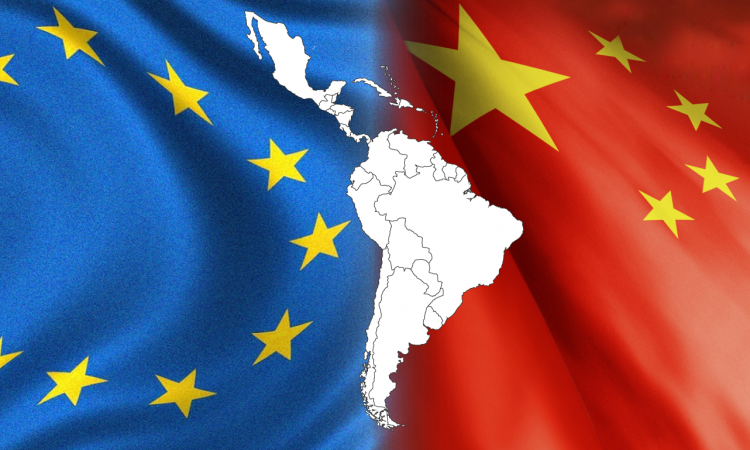Key Findings:
- In November, Vice President of the European Commission Margaritis Schinas visited four countries to discuss and promote interregional cooperation on issues such as insecurity and illegal migration.
- In 2023, the European Union added Latin America to its Global Gateway initiative, a worldwide investment program focused on strategic sectors in Third-World nations. Although the program started in 2021, it initially invested exclusively in Africa.
- Despite this EU attempt to deepen its presence in Latin America, it will nowhere near surpass China’s—at least in the short term. The Chinese Communist Party’s (CCP) economic presence in the region has grown exponentially since the start of the 21st century, welcomed by socialist presidents such as Evo Morales and Rafael Correa.
Overview
On November 5, 2023, Vice President of the European Commission Margaritis Schinas ended his Latin American work trip, in which he visited Mexico, Brazil, Peru, and Colombia. Schinas stated that the main goal of his visit was “to reinforce EU cooperation with Latin American countries in terms of education, migration, and security.”
In July, prior to Shinas’s visit, Brussels held a summit between the European Union and the Community of Latin American and Caribbean States (CELAC). The latter is a regional, intergovernmental organization founded by socialist leaders, including Hugo Chávez, Luiz Inácio “Lula” da Silva, Rafael Correa, and Néstor Kirchner. CELAC is a left-leaning organization whose goal is to replace the US-backed Organization of American States. All 33 Latin American countries are CELAC members, but, in contrast to the OAS, CELAC leaves out Canada and the United States. Since its creation in 2010, CELAC has been the mediator for integration between Europe and Latin America, including investment and cooperation over trade and research.
At the Brussels EU-CELAC summit in July this year, EU head of diplomacy Josep Borrell contended that “reinforcing” the European Union and Latin American countries’ relationship is “strategically imperative.” For this, EU authorities, including European Commission President Ursula von der Leyen, contend that Europe should increase investment in Latin America through its Global Gateway initiative.
What Is the Global Gateway Initiative?
The Global Gateway initiative is a taxpayer-funded worldwide investment program of the European Union that started in 2021. Its stated purpose is openly progressive: “to tackle the most pressing global challenges, from fighting climate change to improving health systems, and boosting competitiveness and security of global supply chains.”
The initiative started by allocating €150 billion ($165 billion) for investment in multiple infrastructure projects in Africa. However, in 2023 the European Union broadened the initiative to investment in Asia and Latin America. The European Union, through the initiative, will allocate €45 billion in investment during the next three years to fund projects in strategic sectors in Latin America.
In 2023, the initiative launched 90 projects worldwide devoted to “health, education, and research systems globally.” Out of the 90 projects, 18 are in Latin America. The most prominent include:
- The construction of a ferry that connects Guyana and Suriname to Trinidad and Tobago, Barbados, and French Guiana. The goal is to increase transit capacity for passengers and cargo.
- The development of Chile’s hydrogen gas production. The subsidies are supposed to create employment and business opportunities for locals and Europeans, alongside a so-called green energy transition in Chile.
- The placement of EU digital expertise, advisory services to local and regional institutions, and software and digital infrastructure across Latin America.
The Value of EU Trade for Latin America
Although EU trade is important for Latin America, it trails US and Chinese trade. By 2020, trade between the European Union and Latin America was $197 billion. Meanwhile, trade between the United States and Latin America and China and Latin America was $758 billion and $315 billion, respectively, with the latter rising swiftly. The European Union claims, as of 2020, its investment in the region created 2.75 million jobs annually.
On July 17, 2023, Spanish socialist President Pedro Sánchez asserted that EU trade with Latin America had “grown enormously between 2013 and 2022, with a 59 percent increase in imports and 37 percent in exports.” While Latin America has an abundance of minerals and natural resources, Europe has the capital, technology, and know-how that Latin America needs to develop, Sánchez added.
The European Union has multiple trade agreements that cover 25 out of the 33 countries in Latin America. At present the European Union is updating its trade agreements with Chile and Mexico. It is also negotiating with Mercosur countries (Argentina, Brazil, Paraguay, and Uruguay) to finalize a trade agreement that covers topics such as tariffs, regulatory barriers, government procurement, and small enterprises. According to the European Union, it is Mercosur’s largest partner for trade and investment. That is despite no trade agreement at present with the trade bloc, even after a decade of negotiations.
The European Union has a trade agreement with 14 Caribbean countries and three countries of the Andean Community: Colombia, Ecuador, and Peru. The EU-Colombia-Peru-Ecuador Trade Agreement “includes full or partial tariff liberalizations, substantive duty-free quotas, the removal of regulatory or technical non-tariff barriers and the introduction of trade facilitating-measures, such as customs procedures … [It] also liberalizes capital movements, investments, and public procurement markets.”
EU Concerns: Insecurity, Illegal Migration
During his November visit to the region, Schinas met with Peruvian Security Minister Vicente Romero and Colombian Vice President Francia Márquez. He said EU cooperation with these countries is necessary to tackle insecurity and illegal migration, two ongoing challenges in Latin America.
A 2022 Prosegur investigation asserts that Latin America is the most violent region in the world and that the violence is “on an upward trend.” To put this in perspective, 39 out of the 50 cities with the largest reported homicide rates in the world are in Latin America, according to a 2022 report of the Security, Justice, and Peace Council—a Mexican NGO that advocates for peace in the region.
Illegal migration across Latin American borders has become an ordinary phenomenon for millions of people. In April, for example, the Impunity Observer investigated the increase in illegal migrants crossing the Darién Gap on the Colombia-Venezuela border. In Central America, there have been dozens of migrant caravans since 2017 that have crossed El Salvador, Honduras, Guatemala, and Mexico with the objective of entering the United States.
Human smuggling represents a source of income and power for transnational criminal organizations. This is the case of the Venezuelan Aragua’s Train and the Colombian Gulf Clan, which use illegal passages to smuggle people in exchange for fees.
The Growing Chinese Footprint
Despite EU attempts to increase its presence in Latin America, China is commercially and financially more influential in the region. Lin Hua, a researcher at the Institute of Latin American Studies of the Chinese Academy of Social Sciences, asserts that “Latin America remains one of the regions of greatest interest to Chinese investment.”
Marxist leaders in the region facilitated the growth of China’s presence in the region. For example, Bolivian President Evo Morales (2006–2019) and Ecuador’s Rafael Correa (2007–2017), instead of turning to the United States or the European Union for infrastructure and energy financing, turned to the CCP.
Since 2005, China’s Export-Import Bank and Development Bank have handed Latin American countries more than $141 billion in loans. This is more than any Western financial institution on its own, including the World Bank, the Inter-American Development Bank, and the Latin American Development Bank. Many Chinese loans in the region are corrosive capital, which means they undermine the recipients’ institutions through bribery of local officials, nontransparent contract clauses, and higher interest rates.
The European Union, despite demonstrating enthusiasm for increased investment in the region, is far from dethroning the CCP as Latin America’s second-largest trading partner. That is not to say the European Union should engage in a pissing contest with taxpayer funds. Rather, the disparity indicates the lengths to which the CCP has prioritized foreign investment as a vehicle for soft power. The EU initiative, with more modest funds, has focused on an ideological agenda. Whether that ramps up in coming years—perhaps secondarily to better access Latin America’s natural resources—remains to be seen.
The competition for dominance in Latin America might on face value seem like a boon for the region: more resources flowing in and employment opportunities resulting, at least initially. However, the adage that there is no such thing as a free lunch is prescient. Both EU and CCP investment comes with strings and seeks an agenda that is not of Latin America’s making.
 Join us in our mission to foster positive relations between the United States and Latin America through independent journalism.
Join us in our mission to foster positive relations between the United States and Latin America through independent journalism.
As we improve our quality and deepen our coverage, we wish to make the Impunity Observer financially sustainable and reader-oriented. In return, we ask that you show your support in the form of subscriptions.
Non-subscribers can read up to six articles per month. Subscribe here.



